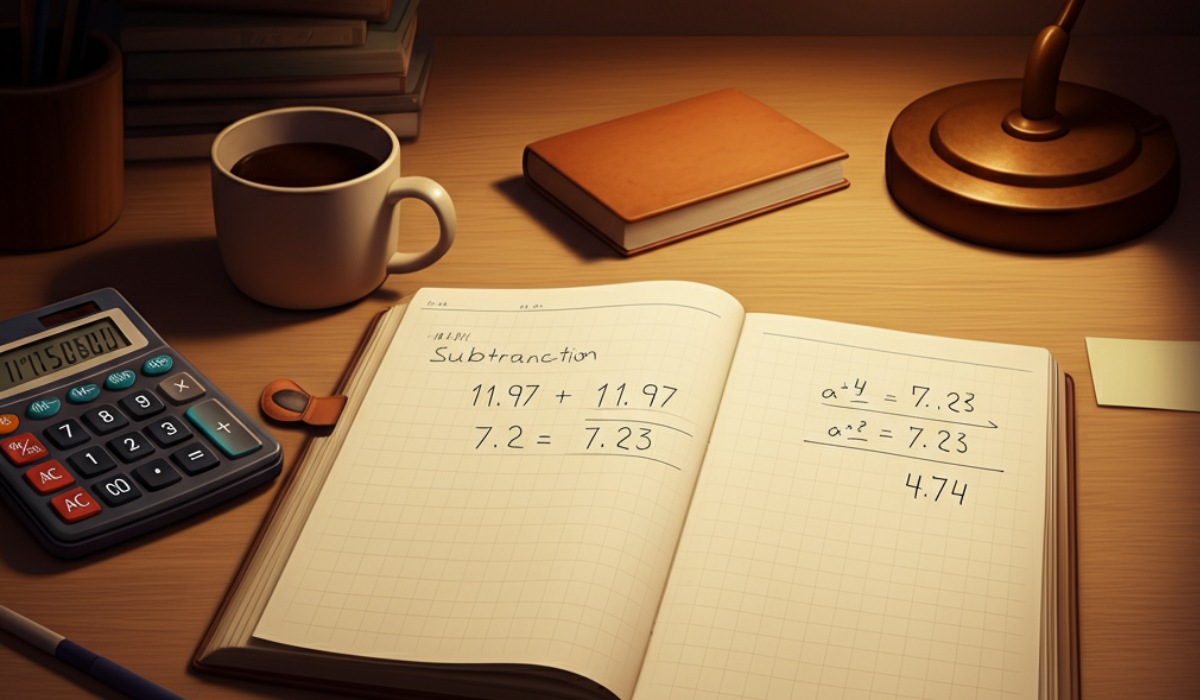Numbers are part of our everyday lives, whether we’re balancing budgets, measuring materials for a recipe, or analyzing data. But have you ever paused to consider what happens when we compare two numbers such as 11.97 and 7.23? At first glance, they may seem like ordinary figures, but understanding the differences between them can provide valuable insights into mathematical principles and their practical applications.
Today, we’ll look at how to determine the difference between 11.97 and 7.23, why decimal places are key, and how such differences influence decisions in finance, engineering, and daily life. Prepare to uncover more than just a numerical gap.
Understanding the Basics: What Does “Difference” Mean?
When we talk about the “difference” between two numbers, we are referring to the result of subtracting one number from another. This mathematical operation answers the question, “By how much does one value exceed the other?”
For 11.97 and 7.23:
11.97 – 7.23 = 4.74
The difference is 4.74. This may seem like a straightforward calculation, but 4.74 can tell its own story depending on the context.
Why Do Decimal Places Matter?
Both 11.97 and 7.23 are decimal numbers, meaning they include digits beyond the decimal point. These additional digits represent fractions of a whole number. Here’s why they matter:
- Precision:
- Decimal places allow for greater accuracy, especially in scenarios such as financial transactions, scientific experiments, and engineering calculations. For instance, comparing $11.97 to $7.23 gives an exact difference of $4.74, which is far more precise than simply rounding numbers to whole dollars.
- Real-World Applications:
- Decimal differences are critical in cases like measuring ingredients in recipes (e.g., 11.97 ounces vs. 7.23 ounces) or calculating distances or weights where precision is essential.
Practical Scenario:
Imagine you’re splitting a bill between friends. If the total is $11.97 and your friend covers $7.23, you’ll owe exactly $4.74. Ignoring decimals here could lead to over- or underpaying, which can add up over time.
Exploring the Contexts of 11.97 and 7.23
1. Finance
The difference between $11.97 and $7.23 might represent the cost distinction between two products or services. For example:
- A latte costing $11.97 at a fancy café compared to one priced at $7.23 at a local shop results in a $4.74 premium. The precise gap helps assess value for money.
- When calculating taxes, these decimal values are measured to ensure fairness and accuracy.
2. Measurements & Engineering
When building structures or performing scientific experiments, every decimal point can matter. For instance:
- If a piece of material is 11.97 cm long but another is 7.23 cm, the 4.74 cm difference could determine whether they fit together.
- Overlooking these differences could lead to costly errors or even safety risks in projects.
3. Everyday Mathematics
Even in ordinary life, differences between numbers appear frequently:
- Comparing prices while shopping
- Tracking calories when dieting
- Adjusting thermostats by decimal degrees for precision comfort
The Calculation Process: Breaking It Down
What’s fascinating about calculating 11.97 minus 7.23 is how clear the process becomes with simple subtraction techniques. For clarity:
- Align the numbers by their decimal points.
- Subtract each column, starting from the rightmost digit.
- Borrow from the higher place values when needed.
- 7.23 subtracted from 11.97 yields 4.74.
This simple method underscores why subtraction—and paying attention to detail—is one of the essential cornerstones of arithmetic.
The Bigger Picture: Why Do Differences Matter?
Understanding differences isn’t just about performing accurate calculations; it’s about applying them meaningfully. Precision differences like 4.74 may seem minor, but over time, small variances accumulate. Take these real-world examples:
- Budgeting: Small expenses saved daily, like $4.74, can lead to significant savings over a year.
- Measurement Systems: Miscalculating differences in weight or length could alter product quality or performance.
- Health: Tracking minute differences in blood pressure readings or medication dosages can impact treatments and outcomes.
FAQs About 11.97 and 7.23
What does the difference of 4.74 represent?
The value 4.74 is the numerical gap between 11.97 and 7.23. This difference can be applied to contexts such as finances, measurements, or any scenario needing precise calculations.
How is the difference calculated manually?
Subtract 7.23 from 11.97 by aligning the decimals and borrowing where needed:
- 11.97
- -7.23
Result = 4.74
Why are decimal differences important?
Decimal differences ensure precise outcomes in finances, engineering, science, and everyday tasks, where rounding errors could have substantial impacts.
Key Takeaways
The difference between 11.97 and 7.23—though just 4.74—is an essential reminder of how important precision is in daily life. From accurate budgeting to safe construction, these small values hold remarkable significance.
Whether you’re working out decimals for schoolwork, analyzing data at your job, or simply ensuring fair financial transactions, a firm grasp of such calculations will always serve you well.

